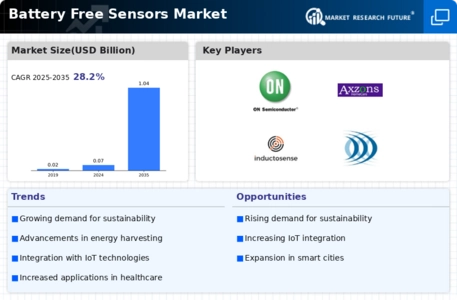Leading market players are investing significant resources to R&D to stay at the forefront of technological advancements. Continuous innovation helps in developing more efficient and reliable Battery-free sensor solutions, giving them a competitive edge. Market participants are also undertaking a variety of strategic activities to expand their global presence, with important market developments including new product launches, contractual agreements, product portfolio diversification, mergers and acquisitions, higher investments, and collaboration with other organizations. To expand and survive in a more competitive and rising market climate, Battery Free Sensors industry must offer innovative solution.
Providing customizable solutions to meet specific customer requirements is one of the key business tactics used by manufacturers in the global Battery Free Sensors industry to benefit clients and increase the market share. In recent years, the Battery Free Sensors industry has offered some of the most significant advantages to Consumers. Major players in the Battery Free Sensors Market, including ON Semiconductor, Axzon, Farsens, Inductosense, and Phase IV Engineering, and others, are attempting to increase market demand by investing in product development to increase their product line and cater to diverse consumer needs.
Everactive, headquartered in Santa Clara, CA, with additional offices in Charlottesville, VA, and Ann Arbor, MI, is a pioneer in the IoT space, empowering developers to create connected products without the constraints of Batteryies. The company provides a cutting-edge hardware toolkit and a managed network tailored for self-powered devices, facilitating the design of sustainable, scalable, and cost-effective IoT solutions. Leveraging proprietary low-power energy harvesting and wireless technology, Everactive enables Batteryless and always-on IoT systems, analyzing vast amounts of data across diverse applications and environments.
Their self-powered IoT platform, driven by groundbreaking ultra-low-power circuit design, allows Eversensors to operate exclusively on harvested energy. Everactive's innovative approach opens avenues for hyperscale IoT applications, marking the company as a leader in advancing energy-efficient and self-sustaining IoT technologies. In May 2021, Everactive introduced an upgraded version of its Steam Trap Monitoring (STM) system, engineered to provide predictive maintenance for expansive steam system deployments. The STM from Everactive is an IoT system tailored for steam traps, operating without Batteryies. It employs Batteryless Eversensors that connect wirelessly to an IoT gateway through the Evernet 2.0 wireless network.
This advancement enhances the efficiency of monitoring and maintaining large-scale steam systems by utilizing innovative, energy-efficient technology.
Founded in 1992 in Boulder, CO, Phase IV Engineering has been a trailblazer in wireless sensing, led by founder Rich Pollack. Initially established as a "Skunk Works," the company specializes in designing cutting-edge sensors for Fortune 500 companies, NASA, the US military, and scientific research. Notably, Phase IV pioneered the world's first Battery-free RFID wireless temperature and pressure sensor, widely deployed in Boeing 777 and 787 aircraft. With expertise in energy harvesting, RF design, low-power circuit design, and solutions for harsh environments, Phase IV Engineering boasts over 100 years of combined experience.
Recognized as the "Sensor Engineering Team of the Year" in 2015 by Sensors Magazine and achieving "Product of the Year" in 2017 from RFID Journal, Phase IV continues to lead in sensor innovation and engineering excellence. In November 2020, Phase IV Engineering and WIKA formalized a partnership agreement aimed at delivering cutting-edge IIoT solutions. WIKA, in August 2020, secured a majority investment in Phase IV Engineering, solidifying their collaborative efforts. This strategic alliance enables Phase IV to provide customers with unparalleled measurement technologies and Industrial Internet of Things (IIoT) solutions, positioning them at the forefront of innovation in the industry.














